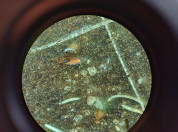Droevendaalsesteeg 10
6708 PB Wageningen
The Netherlands
I foresee that a deep understanding of soil microbial communities will allow us to predict and even steer their activity to benefit crops and the environment
Microorganisms are responsible for decomposing plant material in soil, which makes them central players in greenhouse gas production, soil carbon storage, and recycling of plant nutrients. My research targets the ecological mechanisms of these processes. In particular, I aim to understand how viruses (bacteriophages) shape bacterial communities and redirect the flow of carbon and plant nutrients between plants, soil and atmosphere. This focus fits within the broader goal of understanding soil microbial lifestyles and their interactions with agricultural practice. I study these ecological mechanisms in realistic soil systems using a variety of chemical, stable isotope and molecular tools.
Bacteriophages (phages) infect bacteria to reproduce and are often lethal to their host. To maintain the infection cycle, soil phages must travel from one suitable host to the next. However, traversing the soil matrix presents a dispersal challenge for phages, which need to encounter the right hosts in this spatially complex habitat, but are not capable of active motion and can adsorb to soil particles. Here, we tested the hypothesis that bacterial-feeding nematodes present a reliable vehicle of soil hitchhiking for phages. First, we demonstrated that the bacterivorous nematode Caenorhabditis elegans vectored the laboratory model phage T7 as well as the soil phage Φ Ppu-W11 on agar. Sorption assays carried out with paralyzed and non-paralyzed nematodes showed that phage vectoring can occur via both external cuticular attachment and ingestion, and that the presence of host bacteria is not required for phage vectoring. Finally, we designed a microcosm to test phage transfer in compost and sandy soil using C. elegans and its closely related species, C. remanei, respectively. This experiment confirmed that these nematodes also enable phage movement through spatially complex habitats. This novel mechanism of phage vectoring extends our understanding of virus transmission in soil, revealing new multitrophic interactions that may influence soil functioning.
Associations of iron (hydr)oxides (FeOx) with organic carbon are vital in regulating the stability of soil organic carbon (SOC). Like SOC, FeOx is chemically dynamic in soils, particularly under anaerobic conditions. However, previous research has not clarified how the stability of FeOx (goethite versus ferrihydrite) and the formation pathway of FeOx-OC associations (adsorption versus coprecipitation) affect the stability of FeOx-bound OC and, subsequently, the priming effect (PE) under anaerobic conditions. With an aim to bridge this gap, we incubated paddy soils for 80 d under anaerobic conditions after adding free 13C-glucose, ferrihydrite- or goethite-bound 13C-glucose formed by either adsorption or coprecipitation. Compared with the free glucose addition, the FeOx-bound glucose addition increased 13CO2 production by 8%–21% but reduced 13C–CH4 production by 7%–10%. Ferrihydrite-bound glucose was mineralised more than goethite-bound glucose; this is consistent with its lower crystallinity facilitating reduction and, thus, higher OC bioavailability. Glucose induced a negative priming effect (PE) for CO2 but a positive PE for CH4, whereas FeOx-bound glucose showed the opposite trend. This may be because FeOx-bound glucose provides an energy source and electron acceptor for Fe-reducing bacteria; this promotes the dissimilating reduction of iron and combines with an aggravated microbial P limitation resulting from the FeOx input. The crystallinity of FeOx affected the amount of primed CH4 rather than its formation pathway. In conclusion, the crystallinity of FeOx controls the stability of FeOx-OC associations and the PE of SOC decomposition under anaerobic conditions.
The soil microbiome is recognized as an essential component of healthy soils. Viruses are also diverse and abundant in soils, but their roles in soil systems remain unclear. Here we argue for the consideration of viruses in soil microbial food webs and describe the impact of viruses on soil biogeochemistry. The soil food web is an intricate series of trophic levels that span from autotrophic microorganisms to plants and animals. Each soil system encompasses contrasting and dynamic physicochemical conditions, with labyrinthine habitats composed of particles. Conditions are prone to shifts in space and time, and this variability can obstruct or facilitate interactions of microorganisms and viruses. Because viruses can infect all domains of life, they must be considered as key regulators of soil food web dynamics and biogeochemical cycling. We highlight future research avenues that will enable a more robust understanding of the roles of viruses in soil function and health.
Microbial mineralization of dissolved organic matter (DOM) plays an important role in regulating C and nutrient cycling. Viruses are the most abundant biological agents on Earth, but their effect on the density and activity of soil microorganisms and, consequently, on mineralization of DOM under different temperatures remains poorly understood. To assess the impact of viruses on DOM mineralization, we added soil phage concentrate (active vs. inactive phage control) to four DOM extracts containing inoculated microbial communities and incubated them at 18 °C and 23 °C for 32 days. Infection with active phages generally decreased DOM mineralization at day one and showed accelerated DOM mineralization later (especially from day 5 to 15) compared to that with the inactivated phages. Overall, phage infection increased the microbially driven CO2 release. Notably, while higher temperature increased the total CO2 release, the cumulative CO2 release induced by phage infection (difference between active phages and inactivated control) was not affected. However, higher temperatures advanced the response time of the phages but shortening its active period. Our findings suggest that bacterial predation by phages can significantly affect soil DOM mineralization. Therefore, higher temperatures may accelerate host-phage interactions and thus, the duration of C recycling.
Aims: This study investigated the influence of climate and soil on the exudation rate and polysaccharide composition of aerial nodal root mucilage from drought-resistant and drought-susceptible maize varieties.
Methods: Two maize varieties were grown in two different soils (sandy-clay loam Acrisol and loam Luvisol) under simulated climatic conditions of their agroecological zones of origin in Kenya and Germany. The exudation rate of mucilage from the aerial nodal roots was quantified as dry weight per root tip per day and the mucilage was characterized for its polysaccharide composition.
Results: On average, the mucilage exudation rate was 35.8% higher under the Kenyan semi-arid tropical than under the German humid temperate climatic conditions. However, cultivation in the loam Luvisol soil from Germany led to 73.7% higher mucilage exudation rate than cultivation in the sandy-clay loam Acrisol soil from Kenya, plausibly due to its higher microbial biomass and nutrient availability. The drought-resistant Kenyan maize variety exuded 58.2% more mucilage than the drought-susceptible German variety. On average, mucilage polysaccharides were composed of 40.6% galactose, 26.2% fucose, 13.1% mannose, 11% arabinose, 3.5% glucose, 3.2% xylose, 1.3% glucuronic acid, and 1% an unknown uronic acid. Overall, significantly higher proportions of the uronic acids were found in the mucilage of the plants grown in the Kenyan sandy-clay loam soil and under the Kenyan semi-arid tropical climatic conditions.
Conclusions: Maize is able to enhance its mucilage exudation rate under warm climatic conditions and in soils of high microbial activity to mitigate water stress and support the rhizosphere microbiome, respectively.
Viruses are the most abundant biological entities in the world, but their ecological functions in soil are virtually unknown. We hypothesized that greater abundance of T4-like phages will increase bacterial death and thereby suppress soil organic carbon (SOC) mineralization. A range of phage and bacterial abundances were established in sterilized soil by reinoculation with 10-3 and 10-6 dilutions of suspensions of unsterilized soil. The total and viable 16S rRNA gene abundance (a universal marker for bacteria) was measured by qPCR to determine bacterial abundance, with propidium monoazide (PMA) preapplication to eliminate DNA from non-viable cells. Abundance of the g23 marker gene was used to quantify T4-like phages. A close negative correlation between g23 abundance and viable 16S rRNA gene abundance was observed. High abundance of g23 led to lower viable ratios for bacteria, which suggested that phages drove microbial necromass production. The CO2 efflux from soil increased with bacterial abundance but decreased with higher abundance of T4-like phages. Elimination of extracellular DNA by PMA strengthened the relationship between CO2 efflux and bacterial abundance, suggesting that SOC mineralization by bacteria is strongly reduced by the T4-like phages. A random forest model revealed that abundance of T4-like phages and the abundance ratio of T4-like phages to bacteria are better predictors of SOC mineralization (measured as CO2 efflux) than bacterial abundance. Our study provides experimental evidence of phages' role in organic matter turnover in soil: they can retard SOC decomposition but accelerate bacterial turnover.


Billions of microorganisms live and die in the soil beneath our feet, affecting soil carbon storage and its release to the atmosphere. This project investigates how viruses drive bacterial death and the fate of bacterial remains, to better understand how soil can contribute to maintaining a healthy climate.





